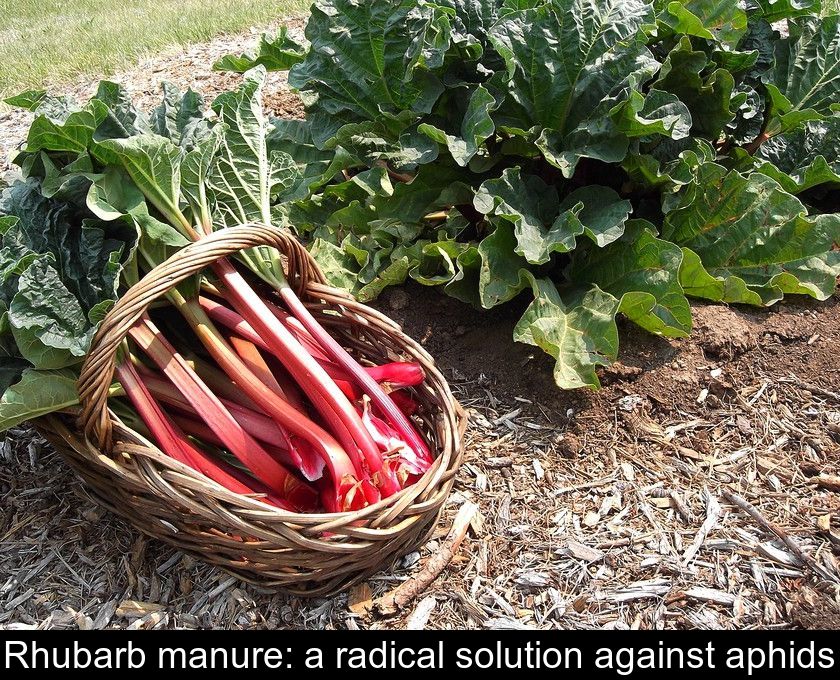Rhubarb Manure: A Radical Solution Against Aphids
Many gardeners feel helpless when aphids invade their crops. However, some have a remarkably effective weapon against these destructive insects right in their garden: rhubarb leaves! We will explain how to prepare rhubarb manure, a solution that is both natural and radical for repelling aphids.
What is rhubarb manure?
Rhubarb slurry is a natural product that you can make yourself by soaking the leaves of this plant in water.
This liquid, when sprayed on plants and vegetables in the garden, helps protect them from attacks by numerous pests.
Indeed, while rhubarb stalks are edible and used to make pies and jams, the leaves of this plant are toxic. They contain oxalic acid, which is dangerous for humans but also for insects.
What is rhubarb manure used for?
Rhubarb manure is appreciated by gardeners for its insect repellent properties.
This natural repellent helps to ward off many insects such as:
• various species of green or black aphids.
• leek moth.
• onion fly.
• carrot fly.
If you notice that your crops are wilting, that the stems are infested with aphids, or that the leaves of your plants are being nibbled, you can use this natural trick. Indeed, manure made from rhubarb leaves is a highly effective weapon against aphids but also slugs.
What equipment is needed to make rhubarb manure?
If you have rhubarb plants in your garden, simply save the leaves after harvesting the stalks.
Note: Since the rhubarb season ends in July, this manure is typically prepared during spring. Adjust the quantity to prepare based on the size of your garden and the number of plants to treat.
To prepare 10 liters of rhubarb manure, you will need:
• 1.5 kg of rhubarb leaves without the petioles.
• 10 l of water, ideally rainwater.
• 1 barrel with a capacity of 15 liters, made of plastic or wood as metal oxidizes.
• 1 cloth or a perforated lid.
• 1 large stick.
• 1 kitchen strainer.
Also, plan for opaque containers to store your manure.
How to make rhubarb manure?
Once you have gathered all the necessary materials, the rhubarb manure recipe is quite simple and quick.
1- Chop the rhubarb leaves.
2- Place them in your barrel or another large non-metallic container.
3- Add 10 liters of water and stir with the stick.
4- Cover the container with a perforated lid or a simple piece of cloth so that air can pass through.
5- Let it macerate for several days, away from light, stirring regularly to activate the fermentation process of the mixture.
Note: after about a week, the fermentation bubbles should have disappeared. This is a sign that your rhubarb manure is ready to be filtered and stored.
6- Pour the manure into opaque cans, filtering it with a kitchen sieve.
7- Store the sealed cans away from heat and light, for example in your cellar or garage. Under these conditions, you can keep your preparation for several weeks.
How to use rhubarb manure?
Once your homemade rhubarb manure is ready, all you have to do is pour it into a sprayer without diluting it.
Against insects such as aphids, this product is used pure and sprayed directly on the invaders, preferably in the evening, to drive them away from your plants.
You can also spray it preventively to keep harmful insects away from your garden, orchard, or vegetable patch...
To maintain its repellent effect, you need to renew the spraying every two weeks and after each rainfall.
For slugs, the instructions are different. It is recommended to dilute the manure in a watering can of rainwater.
Count 1 liter of manure for 5 liters of water, then water your crops with this mixture to prevent slugs from eating them.
Again, you will need to repeat the operation regularly. Remember to add manure to the watering water after each rainfall.







